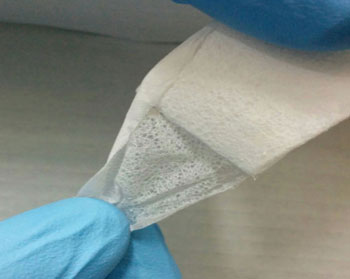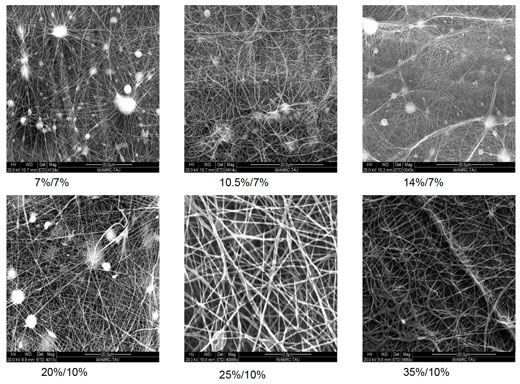| Jul 30, 2019 | |
Jellyfish-based nanofiber/nanoparticle wound dressing |
|
| (Nanowerk Spotlight) Summers at the beach seem to be incomplete without newspaper or TV reports of jellyfish invasions. Some even go as far as warning of the imminent doom of worldwide ocean jellification (although the sensational claim that jellyfish are taking over the oceans is built on wobbly foundations). Nevertheless, jellyfish blooms are a considerable threat, causing considerable and repeated damage to power plant and industrial cooling systems, the fishing industry, and tourism. | |
| Jellyfish aren't all bad, though. They are a known food source for many fish and other marine species and they are a widely eaten delicacy mostly across Asia. Jellyfish are becoming even more overtly beneficial towards humans as recent medical studies have discovered that they may hold potential medical values for many diseases and infections; including arthritis, menstrual pains and gout. Scientists have discovered that jellyfish collagen suppresses arthritis in lab rats and stimulates the immune system and inflammatory responses in humans. | |
| With this in mind, jellyfish may offer more to humans than previously believed and now have even reached the world of nanotechnologies. An international research team reports the successful electrospun-based preparation of novel composite biocompatible nanofibers based on jellyfish biomass (Advanced Functional Materials, "Jellyfish-Based Smart Wound Dressing Devices Containing In Situ Synthesized Antibacterial Nanoparticles"). These nanofibers are decorated with in situ generated bio-templated metallic silver nanoparticles, resulting in a scaffold with potent antibacterial properties. | |
| In this work, the team demonstrates the ease of use of jellyfish biomass as a biodegradable and biocompatible raw material for producing antibacterial mats. | |
 |
|
| Antibacterial wound dressing demonstrated in this work. (Reprinted with permission by Wiley-VCH Verlag) | |
| "While jellyfish bodies consist of 90-95% water, the remaining biomass is mostly composed of cellular and protein materials," Shachar Richter, a professor at Tel Aviv University, who led this study, tells Nanowerk. "These proteins mainly comprise a mixture of collagen and of Q-mucin glycoproteins. The latter are members of a large family of mucusal proteins, which can successfully bind collagen-digesting enzymes, thus allowing growth of new collagen in a dermis layer and promoting wound healing." | |
| Collagen is a major structural protein in animals and applying it to wounds can help encourage skin to heal faster. However, when the collagen comes from mammals such as cows and pigs, as most of it does, it has the potential to transmit conditions such as foot-and-mouth disease. This, and the fact that the extraction processes of this protein involve time- and cost-consuming steps, has thus far limited mammalian source-derived collagen's medical usage. Enters the humble jellyfish... | |
| The researchers processed the whole biomass (not just the collagen) from two species of jellyfish (one from the Mediterranean and one from the Pacific) in several steps and added a solution of polycaprolactone polymer (PCL) until the resultant mixture could be used as the feeding solution for an electrospinning process. | |
| The morphology of the jellyfish/PCL nanofibers depends on the mixture ratio as well as the electrospinning working parameters. | |
 |
|
| Dependence of jellyfish/PCL fibers morphology on jellyfish/PCL w%/w% ratio in constant electrospinning working parameters. (Reprinted with permission by Wiley-VCH Verlag) (click on image to enlarge) | |
| The antibacterial properties of the resulting nanofiber mats were enhanced by incorporating silver nanoparticles within applying an in situ bio-template synthesis that the team developed. | |
| "In our porcine experiments we found that all wounds treated with a wound dressing comprised of our antibacterial jellyfish/PCL nanofiber mats demonstrated progressive healing without complications," Richter notes. "In our test, the performance of our dressing exceeded commercial products." | |
| "Our approach reflects a new paradigm, which suggests exploiting the jellyfish as an accessible, cheap and valuable renewable material that can be used in various applications, such as cosmetics, wound dressings, artificial skin, and bioplastics," he concludes. "Successful production of such materials from two different species of jellyfish that reside in different marine environments suggests the opportunity to utilize the jellyfish in a mass production worldwide." | |
 By
Michael
Berger
– Michael is author of three books by the Royal Society of Chemistry:
Nano-Society: Pushing the Boundaries of Technology,
Nanotechnology: The Future is Tiny, and
Nanoengineering: The Skills and Tools Making Technology Invisible
Copyright ©
Nanowerk LLC
By
Michael
Berger
– Michael is author of three books by the Royal Society of Chemistry:
Nano-Society: Pushing the Boundaries of Technology,
Nanotechnology: The Future is Tiny, and
Nanoengineering: The Skills and Tools Making Technology Invisible
Copyright ©
Nanowerk LLC
|
|
|
Become a Spotlight guest author! Join our large and growing group of guest contributors. Have you just published a scientific paper or have other exciting developments to share with the nanotechnology community? Here is how to publish on nanowerk.com. |
|
